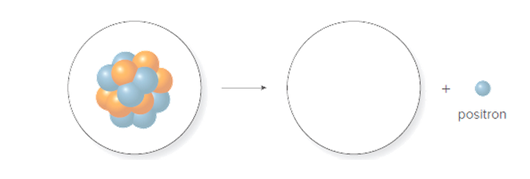
CONNECT IA GENERAL ORGANIC&BIO CHEMISTRY
4th Edition
ISBN: 9781260562620
Author: SMITH
Publisher: MCG
expand_more
expand_more
format_list_bulleted
Concept explainers
Question
Chapter 10, Problem 31P
Interpretation Introduction
Interpretation:
The following

Concept Introduction:
A reaction in which a nucleus of an atom or two nuclei and a subatomic particle collide to form one or more nuclide which is different from the starting nuclide is known as nuclear reaction. Nuclear reactions can be classified as nuclear fission and nuclear fusion.
Expert Solution & Answer
Want to see the full answer?
Check out a sample textbook solution
Students have asked these similar questions
Two cations that exchange an electron in an interface, the exchange density is worth 1.39 mA/cm2 and the current density is worth 15 mA/cm2 at 25°C. If the overvoltage is 0.14 V, calculate the reaction rate and symmetry factor. Data: R = 8,314 J mol-1 k-1: F = 96500 C
With the help of the Tafel line, it is estimated that the interchange density of the VO2+/VO2+ system on the carbon paper has a value of 3 mA cm-2. Calculate a) the current density if the voltage has a value of 1.6 mV and the temperature is 25°C. b) the beta value of the anódico process if the Tafel pendulum is 0.6 V at 25°C. Data: R = 8.314 JK-1mol-1, y F = 96485 C mol-1.
Apply the NANSTE law to the MnO4- + 8H+ + 5e- ⇄ Mn2+ + 4H2O
Chapter 10 Solutions
CONNECT IA GENERAL ORGANIC&BIO CHEMISTRY
Ch. 10.1 - Complete the following table for two isotopes of...Ch. 10.1 - Prob. 10.1PCh. 10.1 - Prob. 10.2PCh. 10.1 - Prob. 10.3PCh. 10.1 - Identify Q in each of the following symbols. a....Ch. 10.2 - Prob. 10.5PCh. 10.2 - Prob. 10.6PCh. 10.2 - Prob. 10.7PCh. 10.2 - Prob. 10.2PPCh. 10.2 - Prob. 10.8P
Ch. 10.2 - Prob. 10.3PPCh. 10.2 - Prob. 10.9PCh. 10.2 - Prob. 10.10PCh. 10.2 - Prob. 10.11PCh. 10.3 - Prob. 10.4PPCh. 10.3 - Prob. 10.12PCh. 10.3 - Prob. 10.13PCh. 10.3 - Prob. 10.14PCh. 10.4 - To treat a thyroid tumor, a patient must be given...Ch. 10.4 - A sample of iodine-131 (t1/2=8.0 days) has an...Ch. 10.4 - Prob. 10.15PCh. 10.5 - Prob. 10.16PCh. 10.5 - Prob. 10.17PCh. 10.5 - Prob. 10.18PCh. 10.6 - Prob. 10.7PPCh. 10.6 - Prob. 10.8PPCh. 10 - Prob. 19PCh. 10 - Prob. 20PCh. 10 - Prob. 21PCh. 10 - Prob. 22PCh. 10 - Prob. 23PCh. 10 - Prob. 24PCh. 10 - Prob. 25PCh. 10 - Prob. 26PCh. 10 - Prob. 27PCh. 10 - Prob. 28PCh. 10 - Prob. 29PCh. 10 - Prob. 30PCh. 10 - Prob. 31PCh. 10 - Prob. 32PCh. 10 - Prob. 33PCh. 10 - Prob. 34PCh. 10 - Prob. 35PCh. 10 - Prob. 36PCh. 10 - Prob. 37PCh. 10 - Prob. 38PCh. 10 - Prob. 39PCh. 10 - Prob. 40PCh. 10 - Prob. 41PCh. 10 - Prob. 42PCh. 10 - Prob. 43PCh. 10 - Prob. 44PCh. 10 - Prob. 45PCh. 10 - Prob. 46PCh. 10 - Prob. 47PCh. 10 - Prob. 48PCh. 10 - Prob. 49PCh. 10 - Prob. 50PCh. 10 - Prob. 51PCh. 10 - Prob. 52PCh. 10 - Prob. 53PCh. 10 - Prob. 54PCh. 10 - Prob. 55PCh. 10 - Prob. 56PCh. 10 - Prob. 57PCh. 10 - Prob. 58PCh. 10 - Prob. 59PCh. 10 - Prob. 60PCh. 10 - Prob. 61PCh. 10 - Prob. 62PCh. 10 - Prob. 63PCh. 10 - Prob. 64PCh. 10 - Prob. 65PCh. 10 - Prob. 66PCh. 10 - Prob. 67PCh. 10 - Prob. 68PCh. 10 - Prob. 69PCh. 10 - Prob. 70PCh. 10 - Prob. 71PCh. 10 - Prob. 72PCh. 10 - Prob. 73PCh. 10 - Prob. 74PCh. 10 - Prob. 75PCh. 10 - Prob. 76PCh. 10 - Prob. 77PCh. 10 - Prob. 78PCh. 10 - Prob. 79PCh. 10 - Prob. 80PCh. 10 - Prob. 81PCh. 10 - Prob. 82PCh. 10 - Prob. 83PCh. 10 - Prob. 84PCh. 10 - Prob. 85PCh. 10 - Prob. 86PCh. 10 - Prob. 87PCh. 10 - Prob. 88PCh. 10 - Prob. 89CPCh. 10 - Prob. 90CP
Knowledge Booster
Learn more about
Need a deep-dive on the concept behind this application? Look no further. Learn more about this topic, chemistry and related others by exploring similar questions and additional content below.Similar questions
- An electrode process takes place at a metal-solution interface. Indicate the current condition that must be met for Faradaic rectification to occur.arrow_forwardAt a metal-solution interface, an electron is exchanged, and the symmetry factor beta < 0.5 is found in the Butler-Volmer equation. What does this indicate?arrow_forwardTopic: Photochemistry and Photophysics of Supramoleculesarrow_forward
arrow_back_ios
SEE MORE QUESTIONS
arrow_forward_ios
Recommended textbooks for you
 Living By Chemistry: First Edition TextbookChemistryISBN:9781559539418Author:Angelica StacyPublisher:MAC HIGHER
Living By Chemistry: First Edition TextbookChemistryISBN:9781559539418Author:Angelica StacyPublisher:MAC HIGHER General, Organic, and Biological ChemistryChemistryISBN:9781285853918Author:H. Stephen StokerPublisher:Cengage Learning
General, Organic, and Biological ChemistryChemistryISBN:9781285853918Author:H. Stephen StokerPublisher:Cengage Learning Chemistry: Principles and PracticeChemistryISBN:9780534420123Author:Daniel L. Reger, Scott R. Goode, David W. Ball, Edward MercerPublisher:Cengage Learning
Chemistry: Principles and PracticeChemistryISBN:9780534420123Author:Daniel L. Reger, Scott R. Goode, David W. Ball, Edward MercerPublisher:Cengage Learning Chemistry: Matter and ChangeChemistryISBN:9780078746376Author:Dinah Zike, Laurel Dingrando, Nicholas Hainen, Cheryl WistromPublisher:Glencoe/McGraw-Hill School Pub Co
Chemistry: Matter and ChangeChemistryISBN:9780078746376Author:Dinah Zike, Laurel Dingrando, Nicholas Hainen, Cheryl WistromPublisher:Glencoe/McGraw-Hill School Pub Co World of Chemistry, 3rd editionChemistryISBN:9781133109655Author:Steven S. Zumdahl, Susan L. Zumdahl, Donald J. DeCostePublisher:Brooks / Cole / Cengage Learning
World of Chemistry, 3rd editionChemistryISBN:9781133109655Author:Steven S. Zumdahl, Susan L. Zumdahl, Donald J. DeCostePublisher:Brooks / Cole / Cengage Learning

Living By Chemistry: First Edition Textbook
Chemistry
ISBN:9781559539418
Author:Angelica Stacy
Publisher:MAC HIGHER

General, Organic, and Biological Chemistry
Chemistry
ISBN:9781285853918
Author:H. Stephen Stoker
Publisher:Cengage Learning

Chemistry: Principles and Practice
Chemistry
ISBN:9780534420123
Author:Daniel L. Reger, Scott R. Goode, David W. Ball, Edward Mercer
Publisher:Cengage Learning


Chemistry: Matter and Change
Chemistry
ISBN:9780078746376
Author:Dinah Zike, Laurel Dingrando, Nicholas Hainen, Cheryl Wistrom
Publisher:Glencoe/McGraw-Hill School Pub Co

World of Chemistry, 3rd edition
Chemistry
ISBN:9781133109655
Author:Steven S. Zumdahl, Susan L. Zumdahl, Donald J. DeCoste
Publisher:Brooks / Cole / Cengage Learning